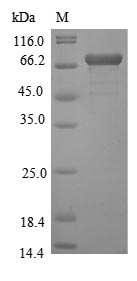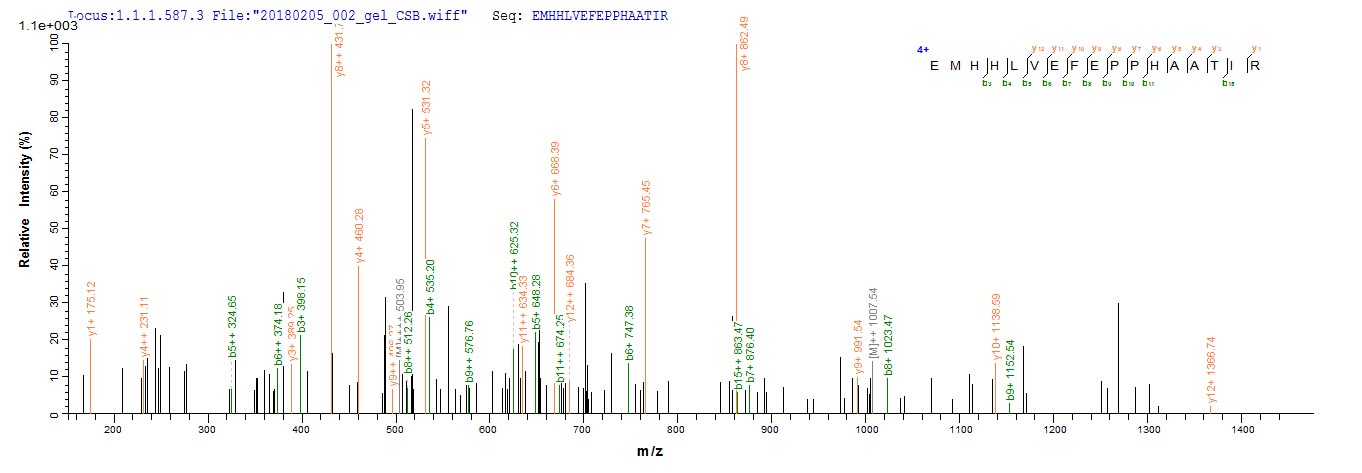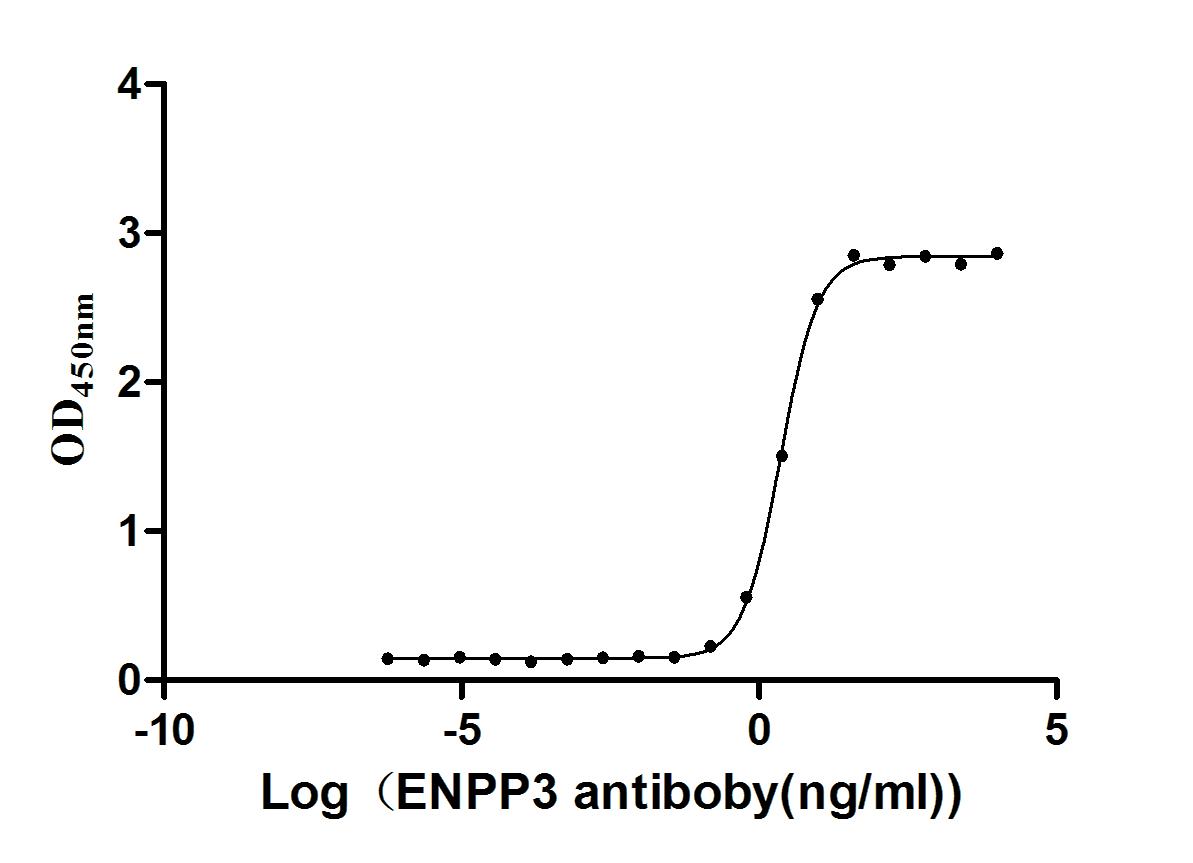Recombinant Yellow fever virus Genome polyprotein, partial
In Stock Promotion-
货号:CSB-EP365905YAC1
-
规格:¥2328
-
促销:

-
图片:
-
(Tris-Glycine gel) Discontinuous SDS-PAGE (reduced) with 5% enrichment gel and 15% separation gel.
-
Based on the SEQUEST from database of E.coli host and target protein, the LC-MS/MS Analysis result of CSB-EP365905YAC1 could indicate that this peptide derived from E.coli-expressed Yellow fever virus (strain 17D vaccine) (YFV) N/A.
-
Based on the SEQUEST from database of E.coli host and target protein, the LC-MS/MS Analysis result of CSB-EP365905YAC1 could indicate that this peptide derived from E.coli-expressed Yellow fever virus (strain 17D vaccine) (YFV) N/A.
-
-
其他:
产品详情
-
纯度:Greater than 85% as determined by SDS-PAGE.
-
基因名:N/A
-
Uniprot No.:
-
别名:; Genome polyprotein [Cleaved into: Capsid protein C; Core protein); Protein prM; Peptide pr; Small envelope protein M; Matrix protein); Envelope protein E; Non-structural protein 1; NS1); Non-structural protein 2A; NS2A); Non-structural protein 2A-alpha; NS2A-alpha); Serine protease subunit NS2B; Flavivirin protease NS2B regulatory subunit; Non-structural protein 2B); Serine protease NS3; EC 3.4.21.91; EC 3.6.1.15; EC 3.6.4.13; Flavivirin protease NS3 catalytic subunit; Non-structural protein 3); Non-structural protein 4A; NS4A); Peptide 2k; Non-structural protein 4B; NS4B); RNA-directed RNA polymerase NS5; EC 2.1.1.56; EC 2.1.1.57; EC 2.7.7.48; Non-structural protein 5)]
-
种属:Yellow fever virus (strain 17D vaccine) (YFV)
-
蛋白长度:Partial
-
来源:E.coli
-
分子量:78.4 kDa
-
表达区域:286-730aa
-
氨基酸序列AHCIGITDRDFIEGVHGGTWVSATLEQDKCVTVMAPDKPSLDISLETVAIDRPAEVRKVCYNAVLTHVKINDKCPSTGEAHLAEENEGDNACKRTYSDRGWGNGCGLFGKGSIVACAKFTCAKSMSLFEVDQTKIQYVIRAQLHVGAKQENWNTDIKTLKFDALSGSQEVEFIGYGKATLECQVQTAVDFGNSYIAEMETESWIVDRQWAQDLTLPWQSGSGGVWREMHHLVEFEPPHAATIRVLALGNQEGSLKTALTGAMRVTKDTNDNNLYKLHGGHVSCRVKLSALTLKGTSYKICTDKMFFVKNPTDTGHGTVVMQVKVSKGAPCRIPVIVADDLTAAINKGILVTVNPIASTNDDEVLIEVNPPFGDSYIIVGRGDSRLTYQWHKEGSSIGKLFTQTMKGVERLAVMGDTAWDFSSAGGFFTSVGKGIHTVFGSAFQGL
Note: The complete sequence including tag sequence, target protein sequence and linker sequence could be provided upon request. -
蛋白标签:N-terminal 10xHis-GST-tagged and C-terminal Myc-tagged
-
产品提供形式:Liquid or Lyophilized powder
Note: We will preferentially ship the format that we have in stock, however, if you have any special requirement for the format, please remark your requirement when placing the order, we will prepare according to your demand. -
缓冲液:Tris-based buffer,50% glycerol
-
储存条件:Store at -20°C/-80°C upon receipt, aliquoting is necessary for mutiple use. Avoid repeated freeze-thaw cycles.
-
保质期:The shelf life is related to many factors, storage state, buffer ingredients, storage temperature and the stability of the protein itself.
Generally, the shelf life of liquid form is 6 months at -20°C/-80°C. The shelf life of lyophilized form is 12 months at -20°C/-80°C. -
货期:3-7 business days
-
注意事项:Repeated freezing and thawing is not recommended. Store working aliquots at 4°C for up to one week.
-
产品描述:
The gene fragment corresponding to the 286-730aa of the Yellow fever virus Genome polyprotein protein was synthesized, with appropriate restriction sites suitable for in-frame cloning into an expression vector, with N-terminal 10xHis-GST tag and C-terminal Myc tag. The E.coli was transformed with the expression vector, and the clone was expressed upon certain induction. After the induced cell centrifugation, the recombinant protein was purified from the cell extract and presented as N-terminal 10xHis-GST-tagged and C-terminal Myc-tagged fusion. This recombinant Yellow fever virus Genome polyprotein protein's purity is greater than 85% assayed by SDS-PAGE. The Genome polyprotein protein ran to a band of about 78 kDa molecular weight on the gel.
Yellow fever virus capsid protein is a potent suppressor of RNA silencing that binds double-stranded RNA. Yellow fever virus encodes a protein that blocks the mosquito’s immune response, suggesting the pathogen’s continued existence in nature depends on staying one step ahead of the vector’s antiviral defense. Yellow fever virus capsid protein is a potent repressor of RNA interference. Although it is known that the flavivirus capsid protein is essential for genome packaging and formation of infectious particles, the minimal requirements of the dimeric capsid protein for virus assembly/disassembly have not been characterized. Yellow fever virus genome polyprotein is also known as Capsid protein C or Core protein. Core Protein-Directed Antivirals and Importin β Can Synergistically Disrupt HBV Capsids.
-
Datasheet & COA:Please contact us to get it.
相关产品
靶点详情
-
功能:Plays a role in virus budding by binding to the cell membrane and gathering the viral RNA into a nucleocapsid that forms the core of a mature virus particle. During virus entry, may induce genome penetration into the host cytoplasm after hemifusion induced by the surface proteins. Can migrate to the cell nucleus where it modulates host functions.; Inhibits RNA silencing by interfering with host Dicer.; Prevents premature fusion activity of envelope proteins in trans-Golgi by binding to envelope protein E at pH6.0. After virion release in extracellular space, gets dissociated from E dimers.; Acts as a chaperone for envelope protein E during intracellular virion assembly by masking and inactivating envelope protein E fusion peptide. prM is the only viral peptide matured by host furin in the trans-Golgi network probably to avoid catastrophic activation of the viral fusion activity in acidic Golgi compartment prior to virion release. prM-E cleavage is inefficient, and many virions are only partially matured. These uncleaved prM would play a role in immune evasion.; May play a role in virus budding. Exerts cytotoxic effects by activating a mitochondrial apoptotic pathway through M ectodomain. May display a viroporin activity.; Binds to host cell surface receptor and mediates fusion between viral and cellular membranes. Envelope protein is synthesized in the endoplasmic reticulum in the form of heterodimer with protein prM. They play a role in virion budding in the ER, and the newly formed immature particle is covered with 60 spikes composed of heterodimer between precursor prM and envelope protein E. The virion is transported to the Golgi apparatus where the low pH causes dissociation of PrM-E heterodimers and formation of E homodimers. prM-E cleavage is inefficient, and many virions are only partially matured. These uncleaved prM would play a role in immune evasion.; Involved in immune evasion, pathogenesis and viral replication. Once cleaved off the polyprotein, is targeted to three destinations: the viral replication cycle, the plasma membrane and the extracellular compartment. Essential for viral replication. Required for formation of the replication complex and recruitment of other non-structural proteins to the ER-derived membrane structures. Excreted as a hexameric lipoparticle that plays a role against host immune response. Antagonizing the complement function. Binds to the host macrophages and dendritic cells. Inhibits signal transduction originating from Toll-like receptor 3 (TLR3).; Component of the viral RNA replication complex that functions in virion assembly and antagonizes the host immune response.; Required cofactor for the serine protease function of NS3. May have membrane-destabilizing activity and form viroporins.; Displays three enzymatic activities: serine protease, NTPase and RNA helicase. NS3 serine protease, in association with NS2B, performs its autocleavage and cleaves the polyprotein at dibasic sites in the cytoplasm: C-prM, NS2A-NS2B, NS2B-NS3, NS3-NS4A, NS4A-2K and NS4B-NS5. NS3 RNA helicase binds RNA and unwinds dsRNA in the 3' to 5' direction. Also plays a role in virus assembly.; Regulates the ATPase activity of the NS3 helicase activity. NS4A allows NS3 helicase to conserve energy during unwinding.; Functions as a signal peptide for NS4B and is required for the interferon antagonism activity of the latter.; Induces the formation of ER-derived membrane vesicles where the viral replication takes place. Inhibits interferon (IFN)-induced host STAT1 phosphorylation and nuclear translocation, thereby preventing the establishment of cellular antiviral state by blocking the IFN-alpha/beta pathway.; Replicates the viral (+) and (-) RNA genome, and performs the capping of genomes in the cytoplasm. NS5 methylates viral RNA cap at guanine N-7 and ribose 2'-O positions. Besides its role in RNA genome replication, also prevents the establishment of cellular antiviral state by blocking the interferon-alpha/beta (IFN-alpha/beta) signaling pathway. IFN-I induces binding of NS5 to host IFN-activated transcription factor STAT2, preventing its transcriptional activity. Host TRIM23 is the E3 ligase that interacts with and polyubiquitinates NS5 to promote its binding to STAT2 and trigger IFN-I signaling inhibition.
-
基因功能参考文献:
- adaptive genetic diversification has occurred on viral nonstructural protein 5 in African and South American yellow fever virus populations PMID: 28044043
- This suggests that DNAJC14's folding activity normally modulates yellow fever virus NS3/4A/2K cleavage events to liberate appropriate levels of NS3 and NS4A and promote replication complex formation. PMID: 26739057
- These data support a complex interplay between yellow fever virus NS2A and NS3 in virion assembly and identify a basic cluster in the NS2A N terminus to be critical in this process.[NS2A, NS3] PMID: 25694595
- Binding of Yellow fever virus NS5 to the IFN-activated transcription factor STAT2 only in cells that have been stimulated with IFN-beta. PMID: 25211074
- While the increase of the positive charge in the envelope protein domain III may reduce the virulence of YFV in mice, this mutation favored the establishment of the viral infection in Aedes aegypti. PMID: 24678844
- These results indicate an interaction of human eIF3L with yellow fever virus NS5 and that eIF3L overexpression facilitates translation, which has potential implications for virus replication. PMID: 23800076
- study shows that the yellow fever virus (YFV) NS5 protein is able to interact with U1A, a protein involved in splicing and polyadenylation; a region between amino acids 368 and 448 was identified as the site of interaction of the NS5 protein with U1A PMID: 21298455
- A combination of several signal peptides contributes to the endoplasmic reticulum-retention of the yellow fever virus envelope protein. PMID: 19846669
- These data indicate that certain mutations that reduce NS2B-NS3 protease cleavage activity cause growth restriction of yellow fever virus in cell culture. PMID: 15831952
- analysis of the yellow fever virus capsid protein PMID: 17526891
- mutation of a conserved tryptophan at position 349 in the helicase domain of NS3 blocks production of infectious virus particles, revealing an as-yet-unknown role for NS3 in virus assembly. PMID: 18199634
- The data suggest phosphorylation of NS5 S56 may act to shut down capping in the viral life cycle. PMID: 18757072
- Casein Kinase 1 phosphorylates serine 56 of yellow fever virus methyltransferase. PMID: 19185594
显示更多
收起更多
-
亚细胞定位:[Capsid protein C]: Virion. Host nucleus. Host cytoplasm, host perinuclear region. Host cytoplasm.; [Peptide pr]: Secreted.; [Small envelope protein M]: Virion membrane; Multi-pass membrane protein. Host endoplasmic reticulum membrane; Multi-pass membrane protein.; [Envelope protein E]: Virion membrane; Multi-pass membrane protein. Host endoplasmic reticulum membrane; Multi-pass membrane protein.; [Non-structural protein 1]: Secreted. Host endoplasmic reticulum membrane; Peripheral membrane protein; Lumenal side.; [Non-structural protein 2A]: Host endoplasmic reticulum membrane; Multi-pass membrane protein.; [Serine protease subunit NS2B]: Host endoplasmic reticulum membrane; Multi-pass membrane protein.; [Serine protease NS3]: Host endoplasmic reticulum membrane; Peripheral membrane protein; Cytoplasmic side.; [Non-structural protein 4A]: Host endoplasmic reticulum membrane; Multi-pass membrane protein.; [Non-structural protein 4B]: Host endoplasmic reticulum membrane; Multi-pass membrane protein.; [RNA-directed RNA polymerase NS5]: Host endoplasmic reticulum membrane; Peripheral membrane protein; Cytoplasmic side. Host nucleus.
-
蛋白家族:Class I-like SAM-binding methyltransferase superfamily, mRNA cap 0-1 NS5-type methyltransferase family
-
数据库链接:
KEGG: vg:1502173
Most popular with customers
-
Recombinant Human E3 ubiquitin-protein ligase ZNRF3 (ZNRF3), partial (Active)
Express system: Mammalian cell
Species: Homo sapiens (Human)
-
Express system: Mammalian cell
Species: Homo sapiens (Human)
-
Recombinant Human Mucin-17 (MUC17), partial (Active)
Express system: Mammalian cell
Species: Homo sapiens (Human)
-
Recombinant Macaca fascicularis lymphocyte antigen 6 family member G6D (LY6G6D) (Active)
Express system: Yeast
Species: Macaca fascicularis (Crab-eating macaque) (Cynomolgus monkey)
-
Recombinant Mouse Cell adhesion molecule 1 (Cadm1), partial (Active)
Express system: Mammalian cell
Species: Mus musculus (Mouse)
-
Recombinant Human Cadherin-17 (CDH17), partial (Active)
Express system: Mammalian cell
Species: Homo sapiens (Human)
-
Recombinant Macaca fascicularis CUB domain containing protein 1 (CDCP1), partial (Active)
Express system: Mammalian cell
Species: Macaca fascicularis (Crab-eating macaque) (Cynomolgus monkey)
-
Recombinant Human Carcinoembryonic antigen-related cell adhesion molecule 8(CEACAM8) (Active)
Express system: Mammalian cell
Species: Homo sapiens (Human)























